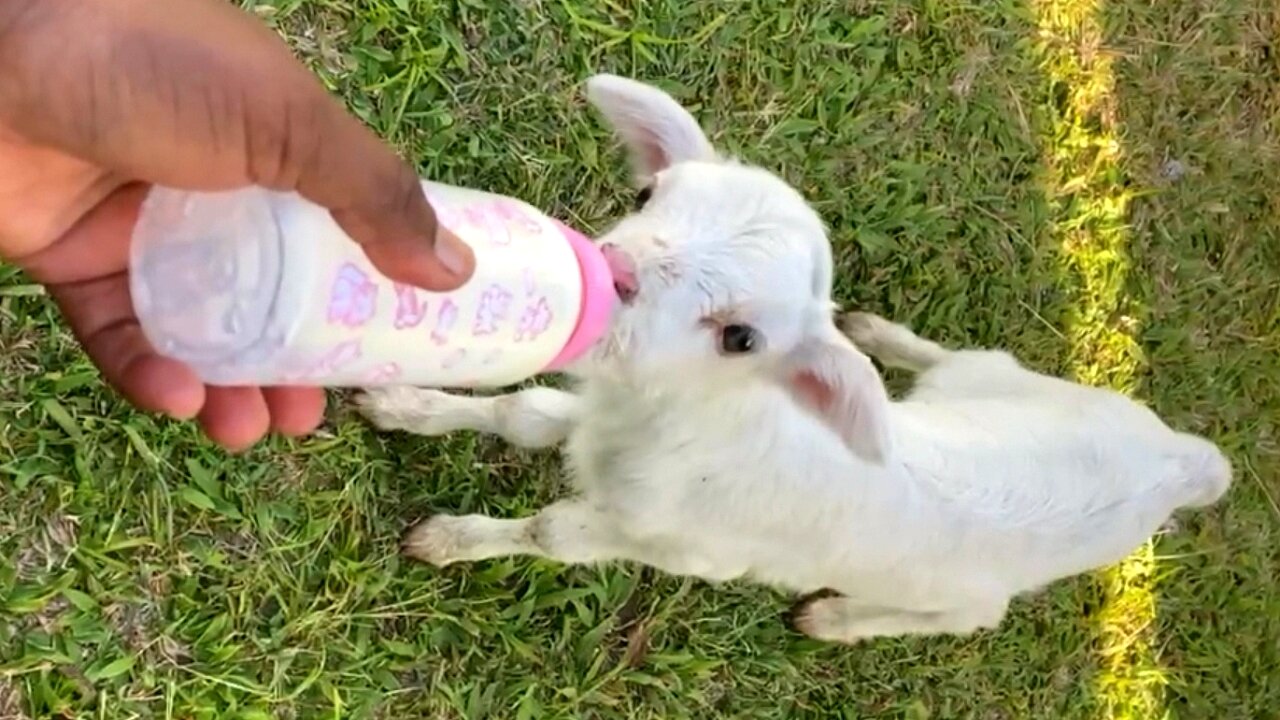Premium Only Content

Why Is Excited Little Susie Spilling Milk While Bottle Feeding
This is little Susie being bottled feed from her owner. Susie lost her mom in an accident while crossing the road. It was a tragic loss for little Susie. Now she is being taken good care of by her owner. Life has been a lot better since then now she gets the proper care that she needs. In this premium video, u will see her bottle-fed and bouncing around happy as can be.
Human to animal breastfeeding has been practiced in some different cultures during various time periods. The practice of breastfeeding or suckling between humans and other species occurred in both directions: women sometimes breastfed young animals, and animals were used to suckle babies and children. Animals were used as substitute wet nurses for infants, particularly after the rise of syphilis increased the health risks of wet nursing. Goats and donkeys were widely used to feed abandoned babies in foundling hospitals in 18th- and 19th-century Europe. Breastfeeding animals has also been practised, whether for perceived health reasons – such as to toughen the nipples and improve the flow of milk – or for religious and cultural purposes. A wide variety of animals have been used for this purpose, including puppies, kittens, piglets and monkeys.
This information is provided to individuals who purchase one or more lambs at a livestock auction, a livestock dealer, or a farm and who are not sure how to properly care for the lamb(s). If you obtain a lamb(s) and you are not quite sure of their age(s), then follow these steps.
If you obtained the baby lamb at an auction or from a farm, you don’t always know if the lamb consumed its mother’s first milk (colostrum). Colostrum is naturally fortified with vitamins, minerals, and antibodies that are essential for a newborn’s survival. If you believe the lamb did not receive colostrum, obtain some from a local sheep producer. Well-prepared shepherds typically keep a supply of colostrum frozen to thaw and warm for such instances. Artificial colostrum for sheep is also available commercially. Newborn lambs need colostrum as their first food within eight hours after birth. The sooner they consume colostrum, the better.
Adding new animals to a farming operation is a potential route for introducing disease. Keep new lambs separate (quarantined) from other animals on the farm for at least 3 weeks. Observe these animals daily and watch for any signs of illness or disease. If they become ill, don’t add them to your flock. In performing your chores, care for the new animals after caring for all others.
Determine if the lamb is male or female. Male lambs (rams) typically grow faster and larger than females (ewes). If the lambs are likely to be kept more than 8 months of age, castration of male lambs at a young age (under 30 days of age) is recommended.
Check both eyes to make sure they are clear, there is no sign of tears, and the eyelid is not inverted and irritating the eye. An irritated eye is red or tearing (wet around and under the eye). Check the mouth to determine if there are sores or scabs around the mouth. If sores or scabs exist, wear disposable gloves when handling the lamb. The lamb may have a disease called “sore mouth” that is communicable to people. In humans, the disease is called “orf” (contagious pustular dermatitis). Wash your hands and arms thoroughly with soap and water if you have handled lambs with a sore mouth.
With one motion, pinch and pull the lamb’s skin by the neck and see if the skin easily returns to the animal’s body. If the skin takes a while after being “tented”, the lamb is likely dehydrated and needs fluids quickly. Purchase unflavored and clear electrolyte from the baby section of the grocery store or drug store to restore the fluid level in dehydrated animals. Use a baby bottle with a nipple to provide the electrolyte.
Weigh the lamb by holding the lamb and standing on a bathroom scale. Subtract your weight to get the weight of the lamb. If the lamb weighs less than 15 pounds, the lamb could be 1 to 20 days of age. Lambs less than 30 days of age will need a liquid diet until about 60 days of age. They will start to nibble lamb ration pellets at about 30 days of age. Provide fresh drinking water at all times for the lamb in a clean bucket that the lamb can easily reach.
If you determine that the lamb is 30 days of age or younger, purchase a baby bottle with nipple from the grocery store or lamb nipples from the farm feed store or livestock supply catalog. Make the hole in the baby bottle nipple larger by slicing a small X across the tip of the nipple with a sharp straight razor blade or utility knife. Don’t make the hole too large. The act of the lamb sucking the nipple will allow the milk to flow at a suitable rate. Purchase lamb milk replacer (specifically formulated for lambs) from the farm and feed store. Read and follow the directions for mixing the formula. For young lambs, make the liquid about the warmth of body temperature. Do not overheat or microwave the formula. The best way to mix the formula is to use warm water and a whisk. As the lamb reaches about two weeks of age, the formula does not have to be warmed. For efficiency, lambs can be trained to suck from a bucket nipple feeder.
Provide the milk replacer to the lamb via the baby bottle and nipple at regular intervals (every 2-3 hours) throughout the day and night as prescribed by the directions on the milk replacer bag. Make sure to thoroughly wash bottles and nipples after use. If the lamb is unable to suck, you may need to provide the formula via a stomach tube. For information about stomach tubing a lamb, contact Cooperative Extension, 207.581.3188 or 800.287.0274 (in Maine), extension@maine.edu
Keep the lamb warm in a small pen and away from any drafts. The pen should be dry with clean bedding. Pine shavings under a layer of straw work well as bedding. A heat lamp will likely be unnecessary – even in Maine. If the air temperature is below 40 degrees F, keep the lamb inside the home or warmed area. Single lambs can be kept in a large cardboard box (open-topped) or a baby playpen. Most lambs that are fed a formula will be able to keep themselves warm even in a barn. Some shepherds cover young lambs with a “jacket” to help them maintain body temperature. A jacket can be made with a single piece of fleece or woolen fabric. Fit the jacket by simply cutting slits for the rear legs and pin the front with safety pins. Stools (droppings) from a healthy baby lamb are usually yellow or light brown in color and has the consistency of caulking compound. As the lamb matures (at about 30 days of age) their stools will become pelleted. Take time to observe that the lamb is relieving itself regularly. Watch that the lamb is both urinating and defecating.
Watch for pelleted droppings from the lamb(s). If your lamb’s stools are loose, cut back on the amount of grain you are providing. Each lamb will likely consume ½ to 2 pounds of grain per day depending on its age.
If the lamb’s age is determined to be over 45 days of age, it can be fed grain (make sure it is a grain mix formulated for lambs), water, and high-quality hay (preferable 2nd crop hay) as their rumen is starting to develop. Be sure to provide fresh, clean water at all times.
To avoid a common disease of lambs called “overeating disease” (enterotoxemia), it is recommended that lambs be vaccinated subq (subcutaneous meaning—under the skin) with a CDT vaccine (2 cc/lamb) at about 30 days of age, then boosted (another 2 cc/lamb) between three and four weeks later. An overview of the CDT vaccine can be found on the CDT Vaccinations for sheep and goats page (MSU Extension). A small vial of CDT vaccine can typically be purchased with 20–gauge needles and 12 cc capacity syringes at the farm/feed store or from your veterinarian. Keep the vaccine refrigerated. A higher gauge needle means a thinner diameter. Thinner needles are less intrusive when used to give an injection for lambs. Weigh the lamb(s) every 7-10 days to make sure it is gaining weight. Keep a record of its weight on a wall calendar. By 2 months of age, a healthy lamb should weigh 40 to 60 pounds.
If you believe the lamb(s) has been on pasture, it is possible that the lamb has internal parasites. A common blood-sucking parasite of sheep is the barber pole worm (Haemonchus contortus). Don’t deworm the lamb unless it is confirmed via stool sample (by your vet) and/or anemia check (FAMACHA). If you have any questions or concerns about raising the lamb(s), don’t hesitate to contact your local Cooperative Extension Office, Extension Livestock Specialist, Dr. Colt Knight (colt.knight@maine.edu), or Extension Veterinarian, Dr. Anne Lichtenwalner (anne.lichtenwalner@maine.edu). Sending photos via smartphone or email is also an option.
-
 1:41
1:41
Kellkell4 Premium Videos
24 days agoA Father's Dark Secret Revealed
541 -
 LIVE
LIVE
The White House
2 hours agoPresident Trump Holds a Press Conference, Aug. 11, 2025
4,824 watching -
 LIVE
LIVE
LFA TV
16 hours agoLFA TV ALL DAY STREAM - MONDAY 8/11/25
4,487 watching -
 LIVE
LIVE
Law&Crime
50 minutes agoLIVE: Wife Dismembered Murder Trial – GA v. Nicholas Kassotis – Day 5 – Part 2
147 watching -
 1:57:03
1:57:03
Dear America
2 hours agoIs Trump Going To Federalize DC TODAY?! + Biden Pardons VOIDED?!?!
79.2K57 -
 LIVE
LIVE
Barry Cunningham
13 hours agoPRESIDENT TRUMP HOLDS PRESS CONFERENCE ABOUT CRIME AND BEAUTIFICATION OF WASHINGTON D.C.
2,046 watching -
 LIVE
LIVE
Caleb Hammer
18 hours ago$350,000+ Of LGBT Debt | Financial Audit
98 watching -
 17:46
17:46
Chris Harden
5 days agoI Found The Mountain Where Retired Millionares Hide
191 -
 LIVE
LIVE
Badlands Media
6 hours agoBadlands Daily: August 11, 2025
3,230 watching -
 40:51
40:51
Randi Hipper
1 hour agoWHITE HOUSE CRYPTO ADVISOR STEPS DOWN! MAJOR BITCOIN NEWS
3.31K3